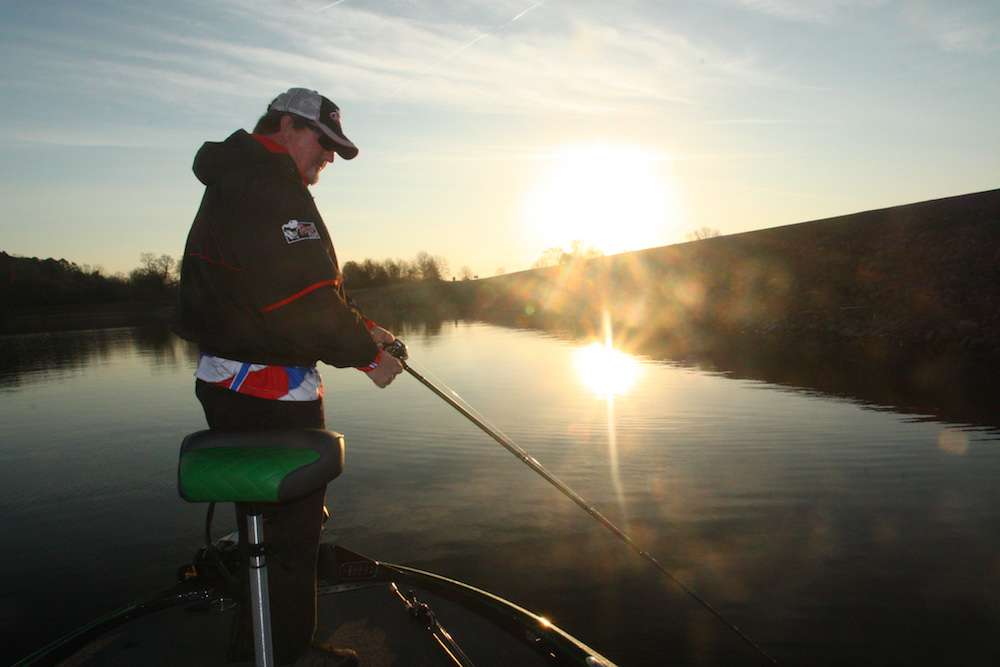
6:40 a.m. We arrive at Lake Râs deserted launch ramp. Fritts, a longtime Ranger pro staff member, is between boats; Iâve arranged to borrow a Triton 21 TrX for our outing. (Bass Pro Shops owns both boat brands.) Fritts pulls a small tacklebag and three of his signature Lewâs Perfect Crank baitcasting rods from his truck; each rod is equipped with a Lewâs BB1 reel spooled with 12-pound Trilene fluorocarbon. âI fish crankbaits on braided line in tournaments, but I forgot to bring any braid with me for this article. With crankbaits, I want the least amount of line stretch possible so I can feel exactly what the lure is doing.â Fritts ties on three of his signature Berkley crankbaits: a lipless vibrating Warpig, a 5/8-ounce Âmedium-diving Dredger 14.5 and a 1/3-ounce Bad Shad 7 shad mimic. What, only three rods!? Most pros start their Day on the Lake with a dozen or more! âHeck, three should be plenty,â Fritts says. 7:05 a.m. We launch the Triton. Fritts checks the lake temp: 52 degrees. âThe water looks clear enough to fish a jerkbait. I brought a couple jerkbaits with me, but Iâd rather crank.â
7 HOURS LEFT7:11 a.m. Fritts makes a short run to Lake Râs dam, which is strewn with riprap. âRock is a prime bass attractor late in the season. I havenât determined yet whether or not this lake has any grass in it, but once the water cools and daylight diminishes, bass will usually vacate grass cover and will head for rock if itâs available.â The boatâs front graph is not working. Many pros would be apoplectic over this malfunction, but Fritts maintains his cool. âHey, it is what it is. The console graph works fine, so maybe you can keep your eye on it and holler out any major depth changes?â 7:12 a.m. Fritts makes his first casts of the day to the dam with the 3/4-ounce Dredger 14.5 in the honey color pattern. I ask him about his reel preferences. âIâve been with Lewâs forever. The BB1 is a slow-speed reel with a 5.1:1 retrieve ratio; it takes up 21 inches of line with each turn of the handle. You donât want a fast-Âcranking reel this time of year; the waterâs cold and the fish tend to be lethargic. The way the BB1 is designed, you can actually feel your lure vibrate through the reel, not just through the rod. I can fish without a graph, but if I canât feel what my lure is doing down there, Iâm lost.â 7:30 a.m. Fritts has cranked the Dredger halfway down the dam; he reverses directions and parallel cranks the plug over 22 feet of water. 7:38 a.m. Still crankinâ riprap. I ask Fritts whether heâs suffered rotator cuff tears, carpal tunnel syndrome or other injuries commonly associated with long-term casting and reeling. âI had to wear a brace on my left arm for a couple months several years back, but nothing beyond that. If I couldnât crank, Iâd probably quit fishing.â
![<b>7:45 a.m.</b> Fritts runs a mile uplake to a primary point, which he cranks with the Dredger. âThis time of year, I look for sharp dropoffs into deep water and places where a deep structure meets a shallower one, like a channel intersecting a flat. And, Iâm not overly concerned about my crankbait bumping off hard objects or the bottom now, because in clear conditions like we have here today, bass often suspend rather than hold tight to cover.â
<p>
<b>6 HOURS LEFT</b><br>
<b>8:08 a.m.</b> Fritts runs to the extreme upper end of Lake R to examine a ditch he located with the console graphâs mapping feature. He cranks the Dredger around the structure. <br>
<b>8:06 a.m.</b> He bags a short fish on the Dredger. <br>
<b>8:07 a.m.</b> The Dredger is digging up strands of dead grass, so Fritts switches to the Bad Shad in the blue back color pattern. âThis lure runs around 8 feet. I designed it to have a distinctive side roll and âtail wagâ that gives it a totally different look than any other shad mimic. Itâs my go-to crankbait in cold, clear water; Iâve had suspending bass swim up 25 feet to grab it.â He promptly catches a short fish on his second cast. âBoth of those rats were hanging right off the edge of the ditch.â <br>
<b>8:10 a.m.</b> Fritts bumps bottom with the Bad Shad. He examines the lure and scrapes a tiny blob of mud off its bill. âYou donât want any mud or grass on your crankbait or itâll mess up its balance.â He hangs a good fish on his next cast, but it comes unbuttoned. âThereâs a bunch of fish around this ditch, but they arenât very aggressive.â <br>
<b>8:14 a.m.</b> Another small bass strikes the Bad Shad. âLast night was the full moon, which usually makes for a tough late-season bite.â <br>
<b>8:18 a.m.</b> Fritts is fancasting the Bad Shad around the outer perimeter of the ditch with a 7-6 cranking rod. âGenerally speaking, the longer the rod, the greater the casting distance, and the shorter the rod, the greater the accuracy. If Iâm fishing open water like I am here, Iâll go for distance with a rod up to 9 feet in length. If Iâm throwing to specific targets, which Iâm usually doing when fishing a squarebill, Iâll use a shorter rod, usually 6-8. I host casting contests for Lewâs around the country; the record distance so far is 99 yards with a 3/4-ounce weight, my signature 7 1/2-foot cranking rod and a Lewâs BB1 reel.â <br>
<b>8:25 a.m.</b> Fritts combs the flat adjacent to the ditch with a 1/2-ounce chameleon pearl Warpig lipless crank. âThe grass is thicker on this flat; I want to try yo-yoing the Pig around it.â The plug snags in the stringy vegetation. âThis dead grass is a pain to fish.â <br>
<b>8:27 a.m.</b> A bass bumps the Bad Shad three times during a single retrieve without hooking up. âTheyâre just head-butting it!â <br>
<b>8:31 a.m.</b> Another nonkeeper hits the Bad Shad. Whatâs Frittsâ biggest crankbait bass, and best crankbait day, ever? âA 9-4, although I had one on at Lake Falcon [Texas] that I estimated at 16 pounds. I once cranked up a five-fish limit on Falcon that weighed 37 pounds and change during a tournament; I actually culled five other limits on that same day that weighed 35 pounds apiece.â <br>
<b>8:44 a.m.</b> Fritts cranks the Merc and idles around to scope out the meandering ditch with his electronics. âThis ditch zigzags all over the place. Iâll come back here later.â He heads back downlake. <br>
<b>8:50 a.m.</b> The wind has picked up as Fritts casts the Bad Shad to a main-lake point. <br>
<b>9 a.m.</b> A good fish slams the Bad Shad on the point but doesnât hook up.](http://www.bassmaster.com/wp-content/uploads/2019/01/07-45_dotl_fritts3_bass.jpg)
6 HOURS LEFT8:08 a.m. Fritts runs to the extreme upper end of Lake R to examine a ditch he located with the console graphâs mapping feature. He cranks the Dredger around the structure. 8:06 a.m. He bags a short fish on the Dredger. 8:07 a.m. The Dredger is digging up strands of dead grass, so Fritts switches to the Bad Shad in the blue back color pattern. âThis lure runs around 8 feet. I designed it to have a distinctive side roll and âtail wagâ that gives it a totally different look than any other shad mimic. Itâs my go-to crankbait in cold, clear water; Iâve had suspending bass swim up 25 feet to grab it.â He promptly catches a short fish on his second cast. âBoth of those rats were hanging right off the edge of the ditch.â 8:10 a.m. Fritts bumps bottom with the Bad Shad. He examines the lure and scrapes a tiny blob of mud off its bill. âYou donât want any mud or grass on your crankbait or itâll mess up its balance.â He hangs a good fish on his next cast, but it comes unbuttoned. âThereâs a bunch of fish around this ditch, but they arenât very aggressive.â 8:14 a.m. Another small bass strikes the Bad Shad. âLast night was the full moon, which usually makes for a tough late-season bite.â 8:18 a.m. Fritts is fancasting the Bad Shad around the outer perimeter of the ditch with a 7-6 cranking rod. âGenerally speaking, the longer the rod, the greater the casting distance, and the shorter the rod, the greater the accuracy. If Iâm fishing open water like I am here, Iâll go for distance with a rod up to 9 feet in length. If Iâm throwing to specific targets, which Iâm usually doing when fishing a squarebill, Iâll use a shorter rod, usually 6-8. I host casting contests for Lewâs around the country; the record distance so far is 99 yards with a 3/4-ounce weight, my signature 7 1/2-foot cranking rod and a Lewâs BB1 reel.â 8:25 a.m. Fritts combs the flat adjacent to the ditch with a 1/2-ounce chameleon pearl Warpig lipless crank. âThe grass is thicker on this flat; I want to try yo-yoing the Pig around it.â The plug snags in the stringy vegetation. âThis dead grass is a pain to fish.â 8:27 a.m. A bass bumps the Bad Shad three times during a single retrieve without hooking up. âTheyâre just head-butting it!â 8:31 a.m. Another nonkeeper hits the Bad Shad. Whatâs Frittsâ biggest crankbait bass, and best crankbait day, ever? âA 9-4, although I had one on at Lake Falcon [Texas] that I estimated at 16 pounds. I once cranked up a five-fish limit on Falcon that weighed 37 pounds and change during a tournament; I actually culled five other limits on that same day that weighed 35 pounds apiece.â 8:44 a.m. Fritts cranks the Merc and idles around to scope out the meandering ditch with his electronics. âThis ditch zigzags all over the place. Iâll come back here later.â He heads back downlake. 8:50 a.m. The wind has picked up as Fritts casts the Bad Shad to a main-lake point. 9 a.m. A good fish slams the Bad Shad on the point but doesnât hook up.
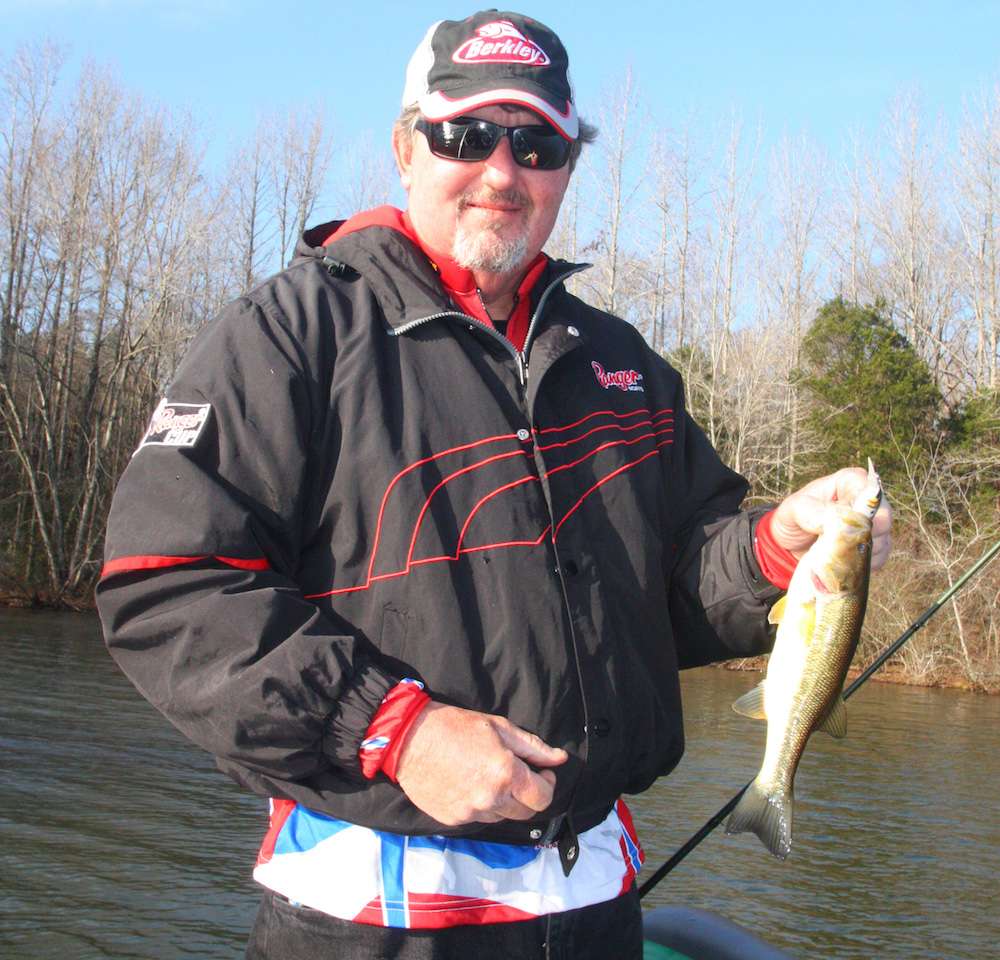
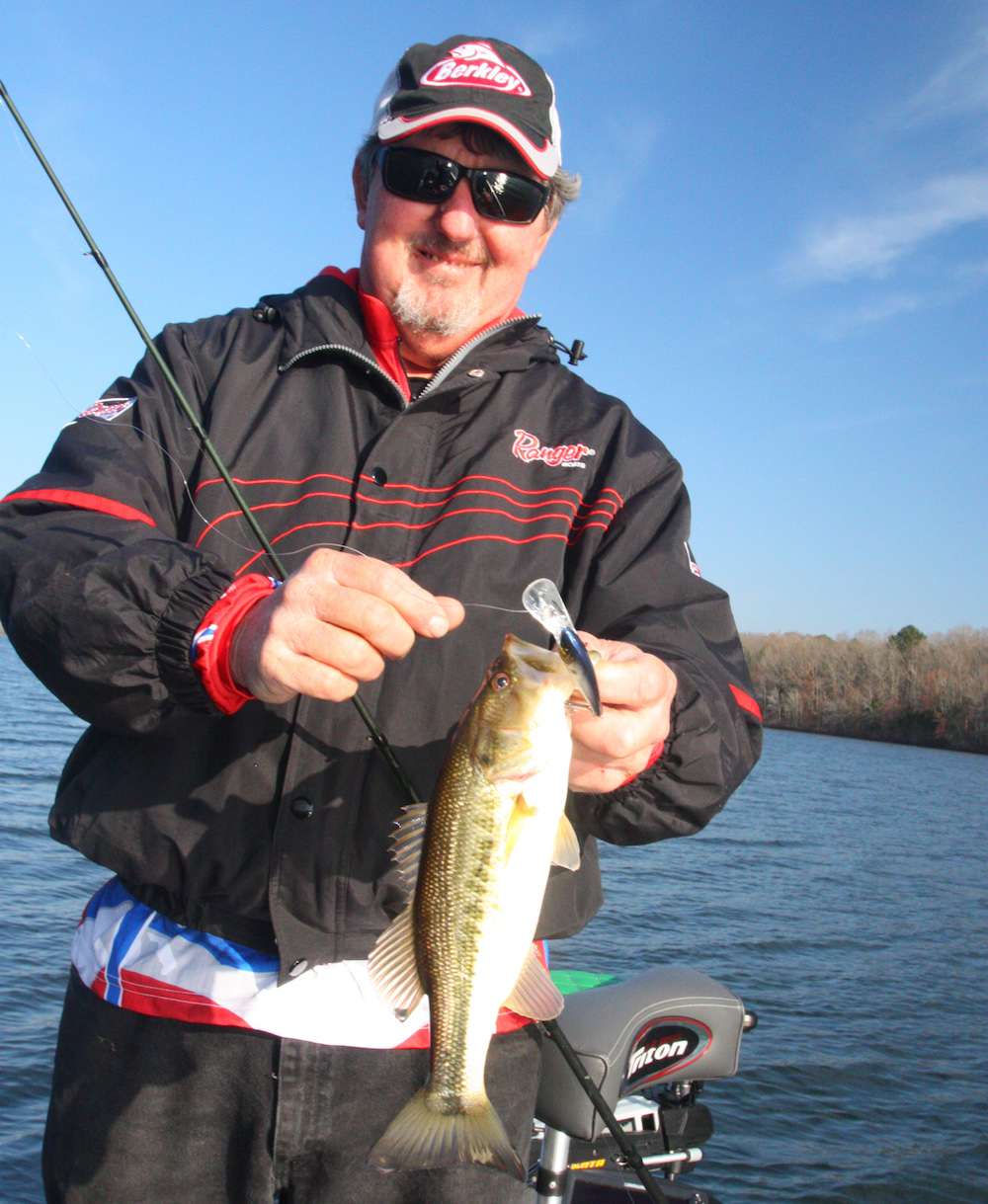
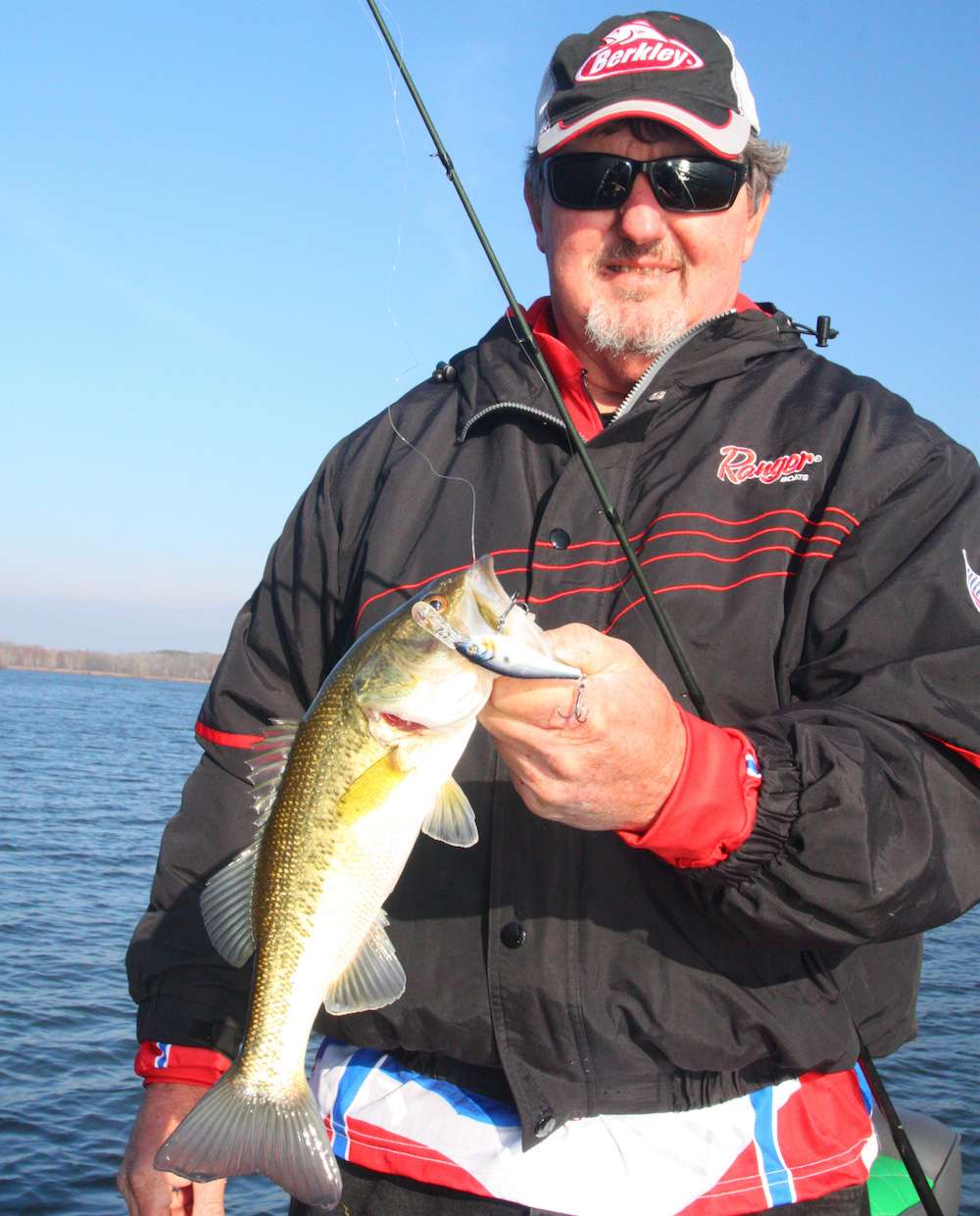
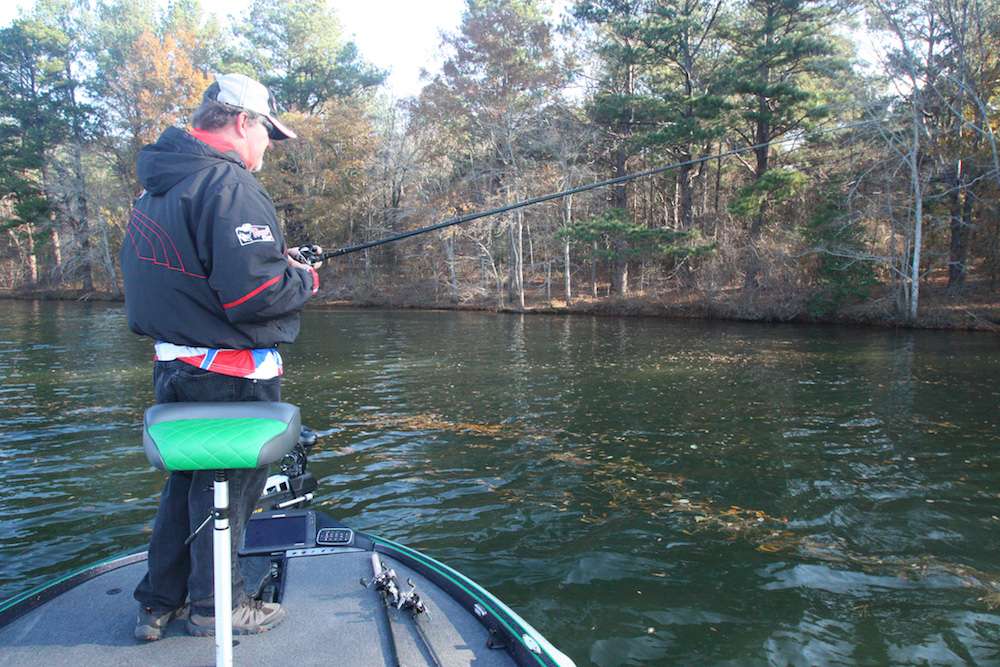
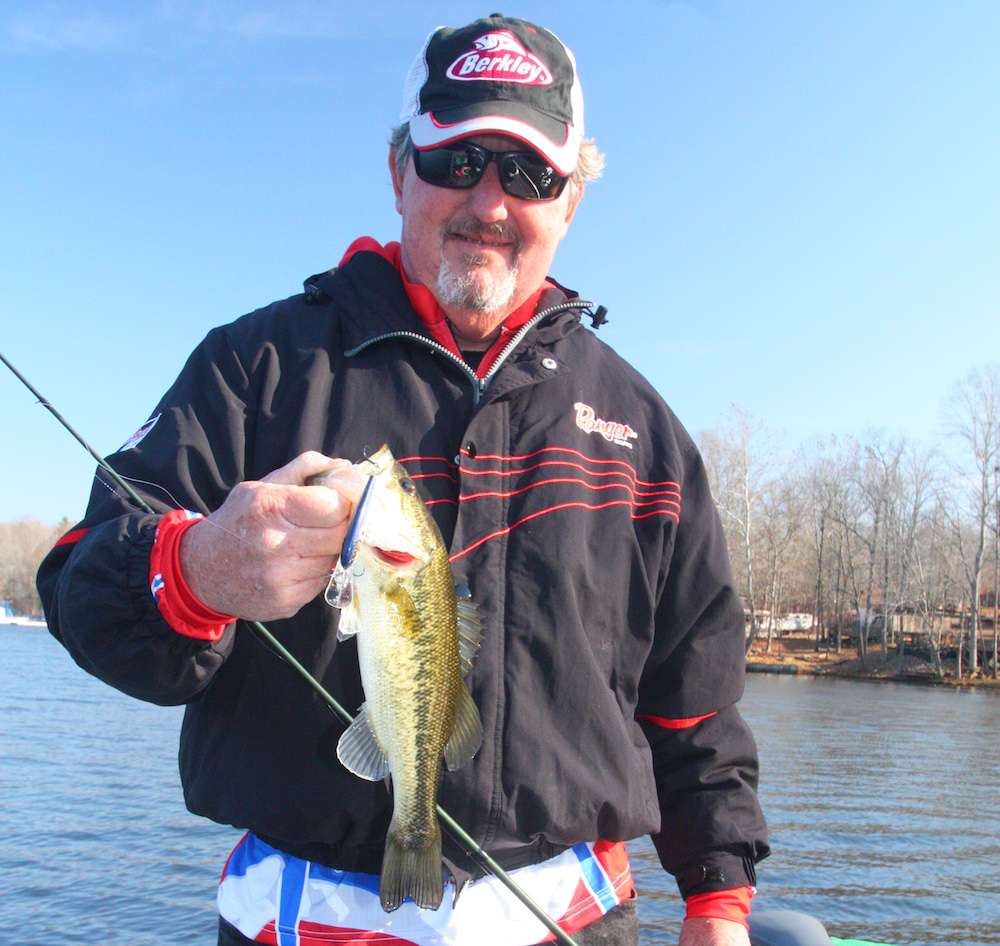
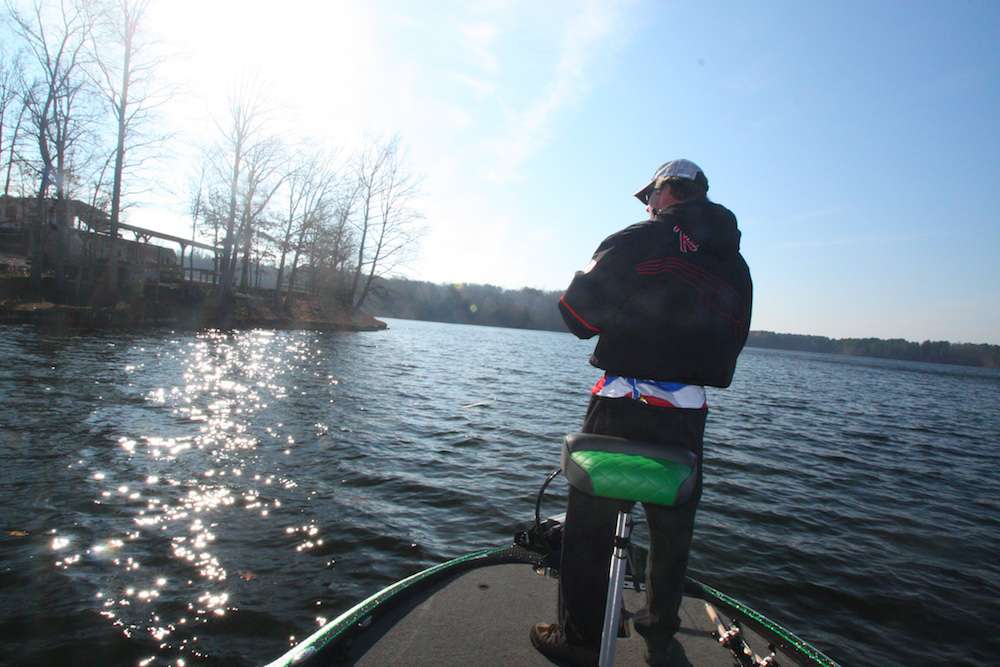
![<b>10:13 a.m.</b> Frittsâ fifth keeper, 2 pounds, 2 ounces, strikes the Bad Shad halfway back to the boat. âThis one was suspended out in open water.â Whatâs his take on the day so far? âIâve managed to put together a limit of small keepers on the Bad Shad. The fish are either shallow or close to where a deep channel or drop cuts into the bank or a flat. The south wind is picking up; that often moves suspending fish up shallower. Iâm going to stick with the pull/stop/pull retrieve and hopefully get on some bigger bites.â <br>
<b>10:22 a.m.</b> Fritts moves to a main-lake point and catches a tiny bass on the Bad Shad. <br>
<b>10:31 a.m.</b> Itâs warming up as Fritts moves farther uplake to hammer another point. A shorty hits the Bad Shad at the boat. âThey definitely arenât stacked on these points; itâs just one fish here and one there.â <br>
<b>10:45 a.m.</b> Fritts wind-drifts around the point to a channel bank. Weâre sitting in 20 feet; heâs throwing to 3 feet. <br>
<b>10:56 a.m.</b> He bags a nonkeeper in the back of a small pocket.
<p>
<b>3 HOURS LEFT</b><br>
<b>11:08 a.m.</b> Still hammering the bank with the Bad Shad. I ask Fritts how it feels to be back fishing B.A.S.S. events. âThe Elites today are totally different from the B.A.S.S. Invitationals and Opens I used to fish. The young kids on the trail are really proficient with their electronics, and they use a lot of methods like drop shotting and shaky heads that Iâve never gotten into. Iâm old school; my boat is loaded with the latest [Raymarine] electronics, but I also still mount flasher units at both the bow and console! Each time I rig a new boat, I pray that my flashers wonât die. You canât get parts anymore!â <br>
<b>11:17 a.m.</b> Fritts idles to another point and cranks the Dredger across the structure. It dredges up a wad of snot grass. <br>
<b>11:25 a.m.</b> The wind is howling as Fritts moves to another point to try the Bad Shad. <br>
<b>11:38 a.m.</b> The point transitions into a sand flat, where Fritts catches a short fish on the Shad. <br>
<b>11:52 a.m.</b> Fritts has fished a 100-yard stretch of channel bank without a strike. âThey obviously ainât where we are!â
<p>
<b>2 HOURS LEFT</b><br>
<b>12:08 p.m.</b> He gets a good hit on the Bad Shad, but thereâs no hookup. <br>](http://www.bassmaster.com/wp-content/uploads/2019/01/10-13_dotl_fritts13_bass.jpg)
3 HOURS LEFT11:08 a.m. Still hammering the bank with the Bad Shad. I ask Fritts how it feels to be back fishing B.A.S.S. events. âThe Elites today are totally different from the B.A.S.S. Invitationals and Opens I used to fish. The young kids on the trail are really proficient with their electronics, and they use a lot of methods like drop shotting and shaky heads that Iâve never gotten into. Iâm old school; my boat is loaded with the latest [Raymarine] electronics, but I also still mount flasher units at both the bow and console! Each time I rig a new boat, I pray that my flashers wonât die. You canât get parts anymore!â 11:17 a.m. Fritts idles to another point and cranks the Dredger across the structure. It dredges up a wad of snot grass. 11:25 a.m. The wind is howling as Fritts moves to another point to try the Bad Shad. 11:38 a.m. The point transitions into a sand flat, where Fritts catches a short fish on the Shad. 11:52 a.m. Fritts has fished a 100-yard stretch of channel bank without a strike. âThey obviously ainât where we are!â
2 HOURS LEFT12:08 p.m. He gets a good hit on the Bad Shad, but thereâs no hookup.
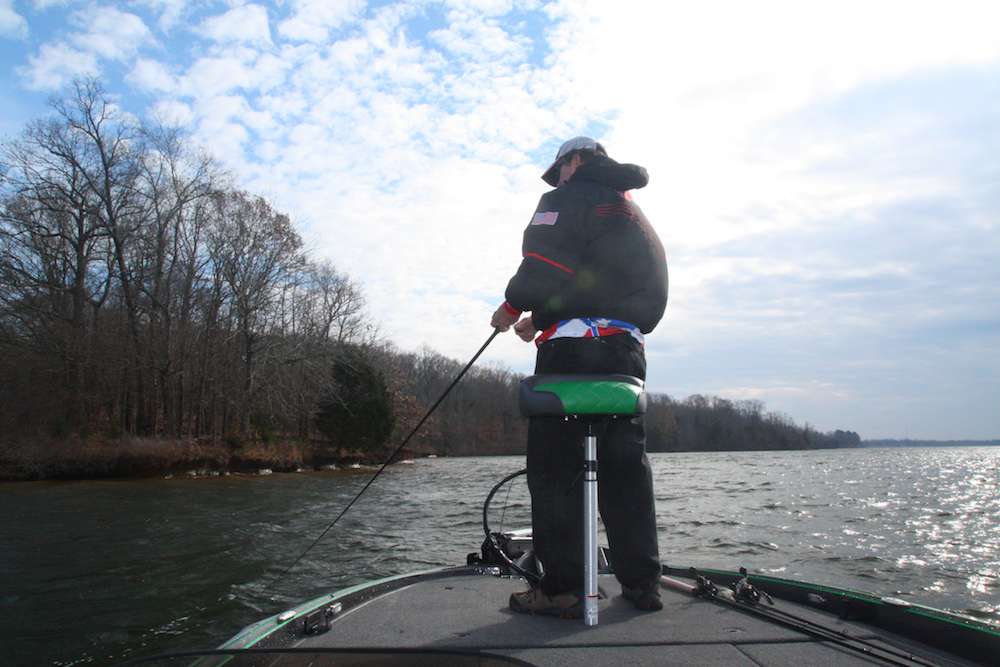
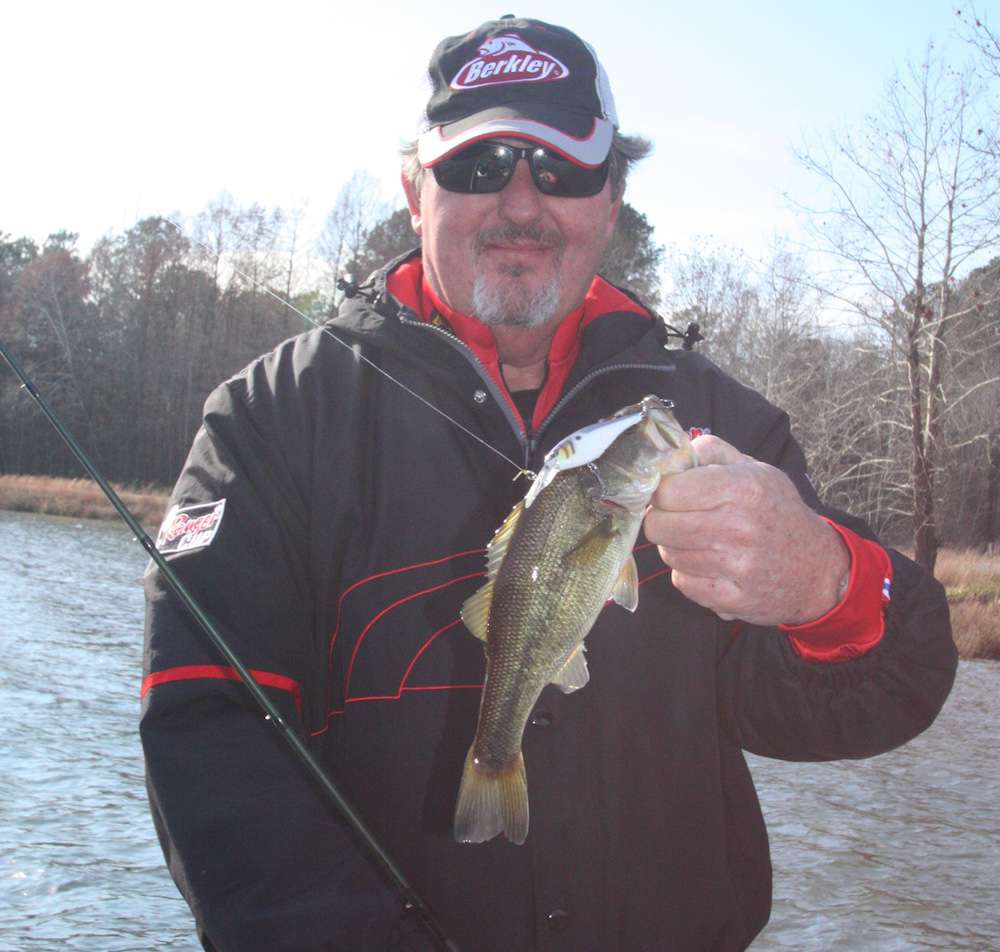
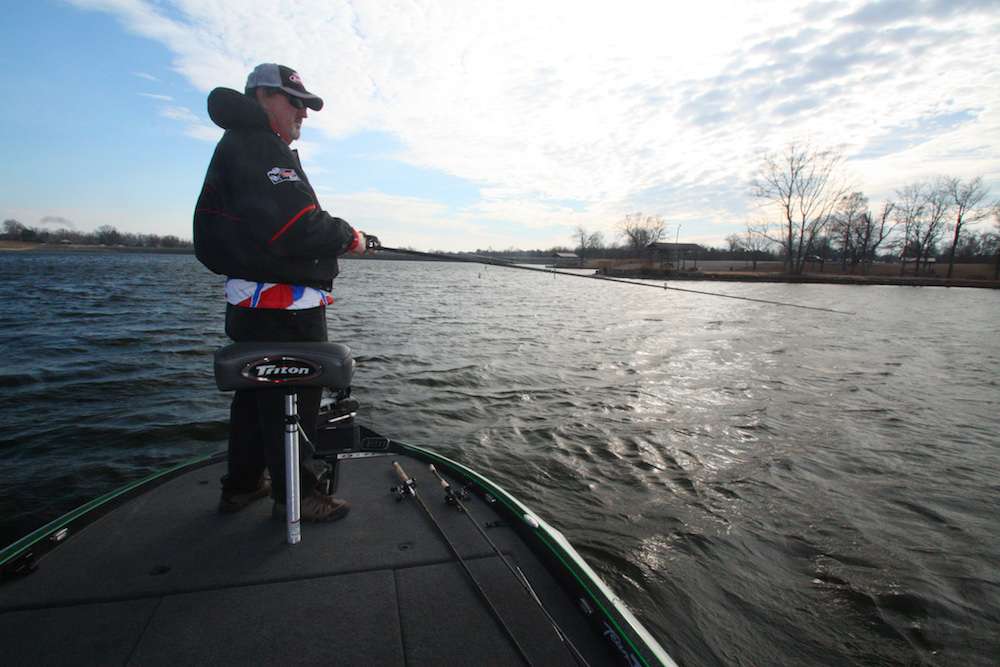
âI had a lot of bites today, but I wasnât contacting quality fish,â Fritts told Bassmaster. âIâm not a big believer in a so-called âbite windowâ where the fish are active and then suddenly shut off; I believe theyâre always biting somewhere, and the challenge is to figure out where. After covering a lot of water today, Iâm convinced that the big fish are out deeper. If I were to fish here tomorrow under these same conditions, Iâd spend more time cranking deeper structure because the Âquality fish obviously havenât moved up yet.â
WHERE AND WHEN FRITTS CAUGHT HIS FIVE BIGGEST BASS
1 pound, 4 ounces; blue back Berkley Bad Shad 7 crankbait; channel bank; 9:14 a.m.
1 pound, 14 ounces; same lure as No. 1; shallow flat between two pockets; 9:16 a.m.
1 pound, 8 ounces; same lure as No. 1; ditch near retaining wall; 10:01 a.m.
2 pounds, 2 ounces; same lure as No. 1; open water adjacent to ditch; 10:13 a.m.
1 pound, 6 ounces; same lure as No. 1; ditch in upper end; 1:05 p.m.
TOTAL: 8 POUNDS, 2 OUNCES
